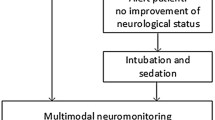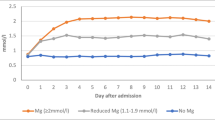Abstract
Background
The aim of this study was to evaluate serum nimodipine concentrations in patients with aneurysmal subarachnoid hemorrhage (SAH) after parenteral therapy and a following course of enteral administration.
Methods
SAH patients were treated with intravenous nimodipine (2 mg/h) during the 1st week after hemorrhage, and on day 8, we switched over to enteral administration (60 mg/4 h), either orally or by gavage. Serum nimodipine concentrations were measured on days 3, 5, 8, 9 and 12. Area under the curve (AUC) was calculated during parenteral and enteral therapy. The data of 15 patients were analyzed retrospectively.
Results
In this study, 157 blood samples were obtained. In seven samples, during the administration by gavage to two patients with high-grade SAH, the serum nimodipine concentrations were negligible. The AUC values during parenteral administration (median 149.3 ng-h/ml) were significantly higher than during oral administration on days 9 (median 92.1 ng-h/ml) and 12 (median 44.1 ng-h/ml) in seven patients (p = 0.030 and p = 0.016, respectively). The AUC values during parenteral administration were significantly higher than during administration by gavage on day 9 in eight patients (median 87.9 and 34 ng-h/ml, respectively, p = 0.001). The AUC values during enteral administration were higher in patients who received nimodine orally than in those who received it by gavage (median 52.3 and 23.1 ng-h/ml, respectively, p = 0.006).
Conclusions
Enteral administration of nimodipine showed lower bioavailability during the 2nd week after SAH compared to parenteral application during the 1st week. Negligible serum concentrations were even expected when nimodipine was given by gavage in patients with high-grade SAH, thus suggesting that parenteral administration may be the better route in these patients.



Similar content being viewed by others
References
Boucher BA, Wood GC, Swanson JM (2006) Pharmacokinetic changes in critical illness. Crit Care Clin 22:255–271, vi
Connolly ES Jr, Rabinstein AA, Carhuapoma JR, Derdeyn CP, Dion J, Higashida RT, Hoh BL, Kirkness CJ, Naidech AM, Ogilvy CS, Patel AB, Thompson BG, Vespa P, American Heart Association Stroke Council; Council on Cardiovascular Radiology and Intervention; Council on Cardiovascular Nursing; Council on Cardiovascular Surgery and Anesthesia; Council on Clinical Cardiology (2012) Guidelines for the management of aneurysmal subarachnoid hemorrhage: a guideline for healthcare professionals from the American Heart Association/American Stroke Association. Stroke 43:1711–1737
Di Pasquale G, Andreoli A, Lusa AM, Urbinati S, Biancoli S, Cere E, Borgatti ML, Pinelli G (1998) Cardiologic complications of subarachnoid hemorrhage. J Neurosurg Sci 42:33–36
Dorhout Mees SM, Rinkel GJ, Feigin VL, Algra A, van den Bergh WM, Vermeulen M, van Gijn J (2007) Calcium antagonists for aneurysmal subarachnoid haemorrhage. Cochrane Database Syst Rev 3:Cd000277
German Socitety of Toxilogical and Forensic Chemistry (2009) Guidelines for quality assurance in forensic-toxicological analyses. German Society of Toxicological and Forensic Chemistry. http://www.gtfch.org/cms/images/stories/files/Appendix%20A%20(GTFCh%2020090601).pdf. Accessed 6 Jul 2014
Hunt WE, Hess RM (1968) Surgical risk as related to time of intervention in the repair of intracranial aneurysms. J Neurosurg 28:14–20
Kronvall E, Undren P, Romner B, Saveland H, Cronqvist M, Nilsson OG (2009) Nimodipine in aneurysmal subarachnoid hemorrhage: a randomized study of intravenous or peroral administration. J Neurosurg 110:58–63
Macmillan CS, Grant IS, Andrews PJ (2002) Pulmonary and cardiac sequelae of subarachnoid haemorrhage: time for active management? Intensive Care Med 28:1012–1023
Macmillan CS, Andrews PJ, Struthers AD (2003) QTc dispersion as a marker for medical complications after severe subarachnoid haemorrhage. Eur J Anaesthesiol 20:537–542
Muck W, Ahr G, Kuhlmann J (1995) Nimodipine. Potential for drug-drug interactions in the elderly. Drugs Aging 6:229–242
Nguyen NQ, Ng MP, Chapman M, Fraser RJ, Holloway RH (2007) The impact of admission diagnosis on gastric emptying in critically ill patients. Crit Care 11:R16
Pickard JD, Murray GD, Illingworth R, Shaw MD, Teasdale GM, Foy PM, Humphrey PR, Lang DA, Nelson R, Richards P et al (1989) Effect of oral nimodipine on cerebral infarction and outcome after subarachnoid haemorrhage: British aneurysm nimodipine trial. BMJ 298:636–642
Rinkel GJ, Algra A (2011) Long-term outcomes of patients with aneurysmal subarachnoid haemorrhage. Lancet Neurol 10:349–356
Rinkel GJ, Feigin VL, Algra A, van den Bergh WM, Vermeulen M, van Gijn J (2005) Calcium antagonists for aneurysmal subarachnoid haemorrhage. Cochrane Database Syst Rev 1:Cd000277
Soppi V, Karamanakos PN, Koivisto T, Kurki MI, Vanninen R, Jaaskelainen JE, Rinne J (2012) A randomized outcome study of enteral versus intravenous nimodipine in 171 patients after acute aneurysmal subarachnoid hemorrhage. World Neurosurg 78:101–109
Soppi V, Kokki H, Koivisto T, Lehtonen M, Helin-Tanninen M, Lehtola S, Rinne J (2007) Early-phase pharmacokinetics of enteral and parenteral nimodipine in patients with acute subarachnoid haemorrhage—a pilot study. Eur J Clin Pharmacol 63:355–361
van Gijn J, Kerr RS, Rinkel GJ (2007) Subarachnoid haemorrhage. Lancet 369:306–318
Vinge E, Andersson KE, Brandt L, Ljunggren B, Nilsson LG, Rosendal-Helgesen S (1986) Pharmacokinetics of nimodipine in patients with aneurysmal subarachnoid haemorrhage. Eur J Clin Pharmacol 30:421–425
Acknowledgments
We would like to thank Ms Svenja Zapf from the Hans Dietrich Herrmann Laboratory, Department of Neurosurgery, University Medical Center Hamburg-Eppendorf, for technical support with the nimodipine assay.
Ethical approval
All procedures performed in this study were in accordance with the ethical standards of the local ethics committee and with the 1964 Helsinki declaration and its later amendments.
For this type of study formal consent was not required.
Conflicts of interest
None.
Author information
Authors and Affiliations
Corresponding author
Rights and permissions
About this article
Cite this article
Abboud, T., Andresen, H., Koeppen, J. et al. Serum levels of nimodipine in enteral and parenteral administration in patients with aneurysmal subarachnoid hemorrhage. Acta Neurochir 157, 763–767 (2015). https://doi.org/10.1007/s00701-015-2369-9
Received:
Accepted:
Published:
Issue Date:
DOI: https://doi.org/10.1007/s00701-015-2369-9




